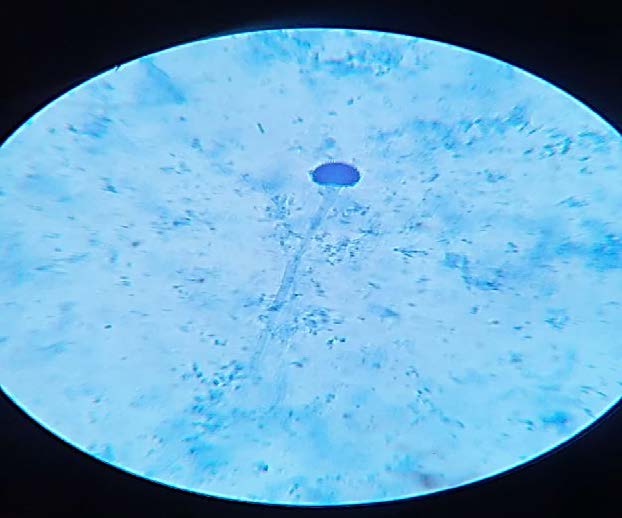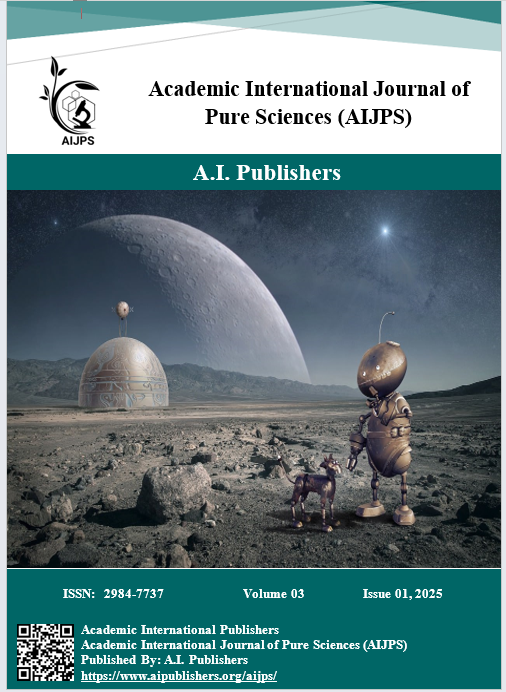Exploring Nutrient Competition and Antimicrobial Strategies in Microbial Communities
DOI:
https://doi.org/10.59675/P314Keywords:
peppers, nutrient competition, chemical materials, acetic acid , sodium chlorideAbstract
The research evaluates the effect of acetic acid and sodium chloride solutions on the competition between microorganisms while studying fungal development patterns in chilli. The research included three distinct chilli groups, which received acetic acid treatment (Group A), sodium chloride treatment (Group C) or no treatment applied (Group B). The observation of macroscopic alterations and fungal infections occurred throughout twelve days. The microbial strains grown on Sabouraud Dextrose Agar (SDA) at 25°C and 37°C underwent microscopic analysis using lactophenol cotton blue stain.
Groups A and C experienced tissue deterioration and fungal growth faster than Group B, which developed visible spots during the eighth day. Most fungi grown on Sabouraud Dextrose Agar (SDA) showed high-temperature tolerance and could probably belong to the genera Aspergillus or Penicillium. The microscopic examination showed hyphae with septations together with conidiophores. Microbial diversity decreases when organisms are exposed to acetic acid and sodium chloride, thus enabling pathogenic fungi to take control since competing microorganisms are harmed. Various microorganisms inside Group B's specimens stopped fungal growth because different microbes competed.
The research demonstrates how microbial diversity maintains fungal-limiting conditions but also shows that we need different preservation techniques to protect beneficial microorganisms. The study successfully determined how microbial competition affects spoilage processes and preservation methods.
References
Samson RA, Visagie CM, Houbraken J, Hong SB, Hubka V, Klaassen CHW, et al. Phylogeny, identification and nomenclature of the genus Aspergillus. Stud Mycol. 2014 Jun;78:141–73.
Egbuta MA, Mwanza M, Babalola OO. A review of the ubiquity of ascomycetes filamentous fungi in relation to their economic and medical importance. Adv Microbiol. 2016;6:1140–58. doi:10.4236/aim.2016.614103.
Shabani F, Kumar L, Esmaeili A. A modelling implementation of climate change on biodegradation of Low-Density Polyethylene (LDPE) by Aspergillus niger in soil. Glob Ecol Conserv. 2015;4:388–98.
Sabotič J, Ohm RA, Kunzler M. Entomotoxic and nematotoxic lectins and protease inhibitors from fungal fruiting bodies. Appl Microbiol Biotechnol. 2016;100(1):91–111.
Vuong MF, Waymack JR. Aspergillosis. StatPearls [Internet]. 2020 [cited 2021 23 April]. Available from: https://www.ncbi.nlm.nih.gov/books/NBK482241/
Tzortzakis NG. Ethanol, vinegar and Origanum vulgare oil vapour suppress the development of anthracnose rot in tomato fruit. Int J Food Microbiol. 2010;142:14–8.
Kemp P, Neumeister KH. Australian Mould Guidelines [Internet]. [cited 2015 16 April]. Available from: [Insert URL if available]
Gubbins PO, Anaissie EJ. Chapter 12: Aspergillosis. In: Clinical Mycology. 2nd ed. Elsevier; 2009.
Davidson PM, Taylor TM. Chemical preservatives and natural antimicrobial compounds. In: Doyle MP, Buchanan RL, editors. Food Microbiology: Fundamentals and Frontiers. 3rd ed. Wiley Online Library; 2017. p. 713–45.
Free SJ. Fungal cell wall organization and biosynthesis. Adv Genet. 2013;81:33–82.
Ibe C, Walker LA, Gow NAR, Munro CA. Unlocking the therapeutic potential of the fungal cell wall: clinical implications and drug resistance. In: Prasad R, editor. Candida albicans: Cellular and Molecular Biology. Springer; 2017. p. 313–46.
Gow NAR, Latge JP, Munro CA. The fungal cell wall: structure, biosynthesis, and function. Microbiol Spectr. 2017;5(3).
Kumar R, Tiwari BK. Sodium chloride as a natural preservative: mechanisms and applications in food industry. Food Biosci. 2022;46:101567.
Oliveira M, Ferreira V. Sodium chloride and its role in controlling foodborne pathogens: a review. Food Res Int. 2023;164:112345.
Treesuwan K, Jirapakkul W, Tongchitpakdee S, Chonhenchob V, Mahakarnchanakul W, Tongkhao K. Antimicrobial mechanism of salt/acid solution on microorganisms isolated from trimmed young coconut. Microorganisms. 2023;11(4):873.
Hibbing ME, Fuqua C, Parsek MR, Peterson SB. Bacterial competition: surviving and thriving in the microbial jungle. Nat Rev Microbiol. 2010;8(1):15–25.
Boddy L, Hiscox J. Fungal ecology: principles and mechanisms of colonization and competition by saprotrophic fungi. Microbiol Spectr. 2016;4(6).
Pitt JI, Hocking AD. Fungi and Food Spoilage. Springer; 2009.
Künzler M. How fungi defend themselves against microbial competitors and animal predators. PLoS Pathog. 2018;14(9):e1007184.
Foster KR, Bell T. Competition, not cooperation, dominates interactions among culturable microbial species. Curr Biol. 2012;22(19):1845–50.
Olaimat AN, Holley RA. Factors influencing the microbial safety of fresh produce: a review. Food Microbiol. 2012;32(1):1–19.

Downloads
Published
Issue
Section
License
Copyright (c) 2025 Academic International Journal of Pure Science

This work is licensed under a Creative Commons Attribution 4.0 International License.





